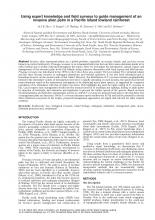Using expert Knowledge and Field Surveys to Guide Management of an Invasive Alien Palm in a Pacific Island Lowland Rainforest


Island and Ocean Ecosystems, BRB
Available Online
Boehmer, H.J.
,
Dyer, M.J.B.
,
Keppel, G.
,
Tuiwawa, M.
,
Vido, S.
,
Watling, D.
2019
Invasive alien ornamental plants are a global problem, especially on oceanic islands, and can have severe impacts on native biodiversity. Pinanga coronata, is an ornamental palm tree that can form mono-dominant stands in its native habitat and is widely cultivated throughout the tropics. Here we investigate the introduction, spread, impact and management of this invasive palm in the Fiji Islands, using extensive discussions with local experts and ?eld surveys. Pinanga coronata was introduced in the 1970s to the Colo-i-Suva area, eastern Viti Levu island, Fiji´s principal island, and has since become invasive in mahogany plantations and lowland rainforest. It has also been introduced and is becoming invasive on the western side of that island. However, the distribution of P. coronata remains geographically limited to the immediate vicinity of introduction sites but it is rapidly spreading. In each location, the species has formed mono-dominant stands in the understorey and appears to be displacing native plant species, as suggested by a negative correlation of its abundance with that of native tree ferns. This highlights the need for rapid control of P. coronata in Fiji. Local experts state management should involve manual removal of seedlings and saplings, killing of adult palms by injection of herbicide, and education and legislation to prevent the further spread of the species. Based on these recommendations and ?eld data, management actions to control P. coronata are proposed and steps to develop these into a management plan are discussed. Given P. coronata threatens native biodiversity in Fiji and has the potential to invade other rainforest ecosystems in the tropics, proposed management approaches are urgent and relevant for other tropical countries.



